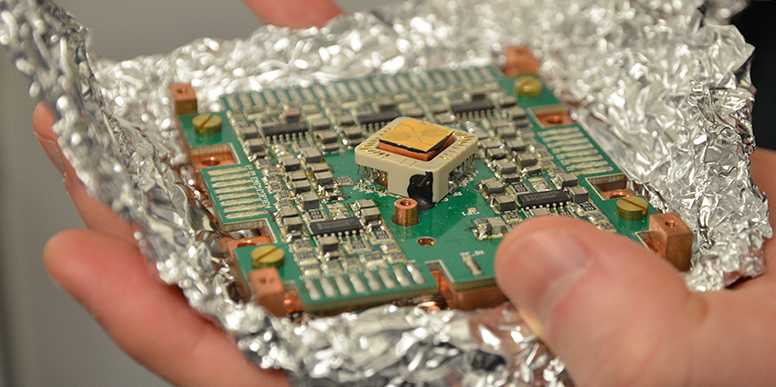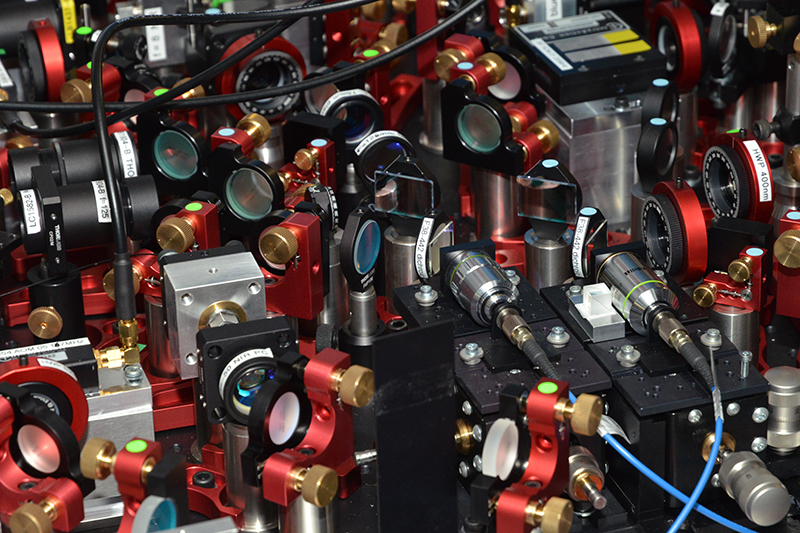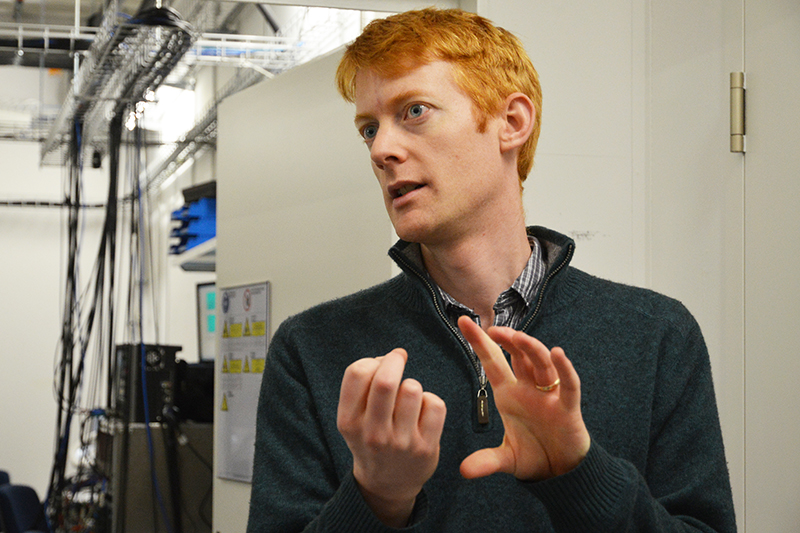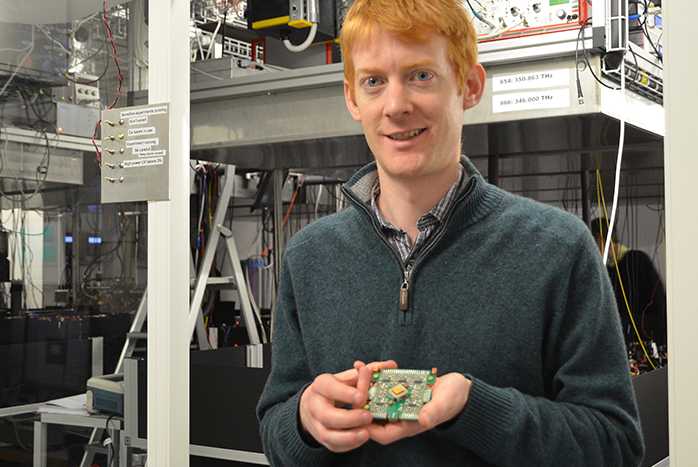Catching qubits in a trap
Jonathan Home’s laboratory has a room full of equipment that traps tiny ions and places them in special quantum states – perhaps the first step towards building a quantum computer.
What is a quantum computer, and what can it do? ETH’s Professor Jonathan Home is heading to Canada to present some answers at the TED Conference, an iconic international innovation get-together that kicks off in Vancouver on 16 March. In announcing Home as a TED Fellow, the organisers have put the 34-year-old British physicist in among a group of young pioneers who have already achieved great things. But Home is a picture of modesty: “My priority is to get the research group here at ETH to perform at its best.” He loves it when his students share ideas of their own in the group’s weekly meeting: “That’s a lot of fun.”

Home’s 13-strong research team is aiming to achieve precision control of individual atoms so they can build them up into quantum systems. His laboratory is located at the Institute for Quantum Electronics on the Hönggerberg campus. The launch pad for the group’s experiments is a black box, one and a half metres tall, with a laser inside. This equipment features the same technology as modern atomic clocks. “But we’re not measuring time,” Home explains. “We’re using the atoms as qubits. What we want to know is what happens when we connect these little guys up – when we try to precisely nudge one atom with another.” This takes place in what is known as an ion trap, which has been built in the room next door.
Cooling with lasers
In that room, a big table holds countless mirrors, lenses and crystals. These direct laser beams of various frequencies onto the ion trap, which is housed in a round chamber at the back of the room. Since the heart of the apparatus is hidden from view, Home shows us a small circuit board that is waiting to be installed, on which is mounted a one‑centimetre metal square. “There’s a slit in the middle of it that’s 10 to 100 micrometres wide; that’s the ion trap,” he explains. Within, individual charged calcium or beryllium atoms sit in a vacuum, surrounded by tiny gold electrodes that can be used to move the ions along the slit.

One thing the laser light does is cool the ions, drawing kinetic energy away from individual particles. Tailored laser pulses can cool an ion to such an extent that it reaches its quantum ground state. In their latest experiment, however, the researchers weren’t looking to achieve individual quantum states but rather a superposition of several special states. “That’s why we modified the cooling,” Home says. Their ingenious system of laser beams at different frequencies was controlled by electronics developed in the laboratory.
Stable over the weekend
Home attempts to put his team’s findings into terms that will mean something to the layperson: In quantum mechanics, we can consider an atom to be a packet of waves. In one state, this packet is of a fixed size and moves to and fro like a pendulum. “But the packet can also get bigger and smaller, as if it were breathing,” Home says. “We call that a squeezed state.” In their experiment, the researchers managed to apply a new method for creating squeezed states, which they described in Science magazine at the end of December.
“The great thing about our cooling method is that these states remain stable over long periods of time,” Home says. “You can create them and they’ll last the whole weekend. That’s not normally the case.” Since their method is so robust, it could potentially be used to simulate complex physical systems – something classical computers can’t do. Whether precision control of individual ions’ quantum states will one day lead to the building of a quantum computer, the researchers don’t yet know.
From a Nobel laureate’s lab to Zurich

Home gathered the experience he needed to carry out these delicate experiments from a number of sources – among them US Nobel laureate David Wineland at the renowned National Institute of Standards and Technology (NIST) in Boulder, Colorado, where Home himself worked after completing his studies at Oxford University. Ten years ago, together with fellow students, Home was also involved in a library and education project in Rwanda. In terms of physics, he freely admits that the undertaking wasn’t particularly successful: “But from an emotional point of view, my stay in Rwanda was very meaningful.”
Home would love to return to Africa someday, but right now he isn’t too interested in invitations to travel abroad, as his wife gave birth to their first child just over a year ago. Since then, his family takes priority; even the violin that he would play for two hours daily as a teenager no longer comes out of its case. But the last thing the young physics professor wants to do is complain about having too much work. “I have a fantastic job,” he grins, adding that ETH offers him the ideal environment for his demanding research. And when it comes to actually carrying out that research, he knows he can rely on enthusiastic support from the technical staff. “Most other universities just don’t have that kind of specialist personnel,” he says.
So how is Home planning to illustrate the functioning of a quantum computer to the people at the TED Conference who don’t have a scientific background? “We can put these atoms in two states at a time, at which point they each behave like a clock, but where we can precisely control the time,” he explains. You can enter vast reams of numbers into this system, and it will process them all in parallel. But how do you know when you’ve found the right answer? For that, he says, you go back to the idea of waves, but waves that are superimposed on each other: “When you’re standing on the seashore and you see the crest of a wave rise up out of the water, then that’s the answer to the problem.”
Literature reference
D. Kienzler, H.-Y. Lo, B. Keitch, L. de Clercq, F. Leupold, F. Lindenfelser, M. Marinelli, V. Negnevitsky, J. P. Home: Quantum harmonic oscillator state synthesis by reservoir engineering, Science, Vol. 347, no. 6217 pp. 53-56, DOI: external page 10.1126/science.1261033


Comments
No comments yet